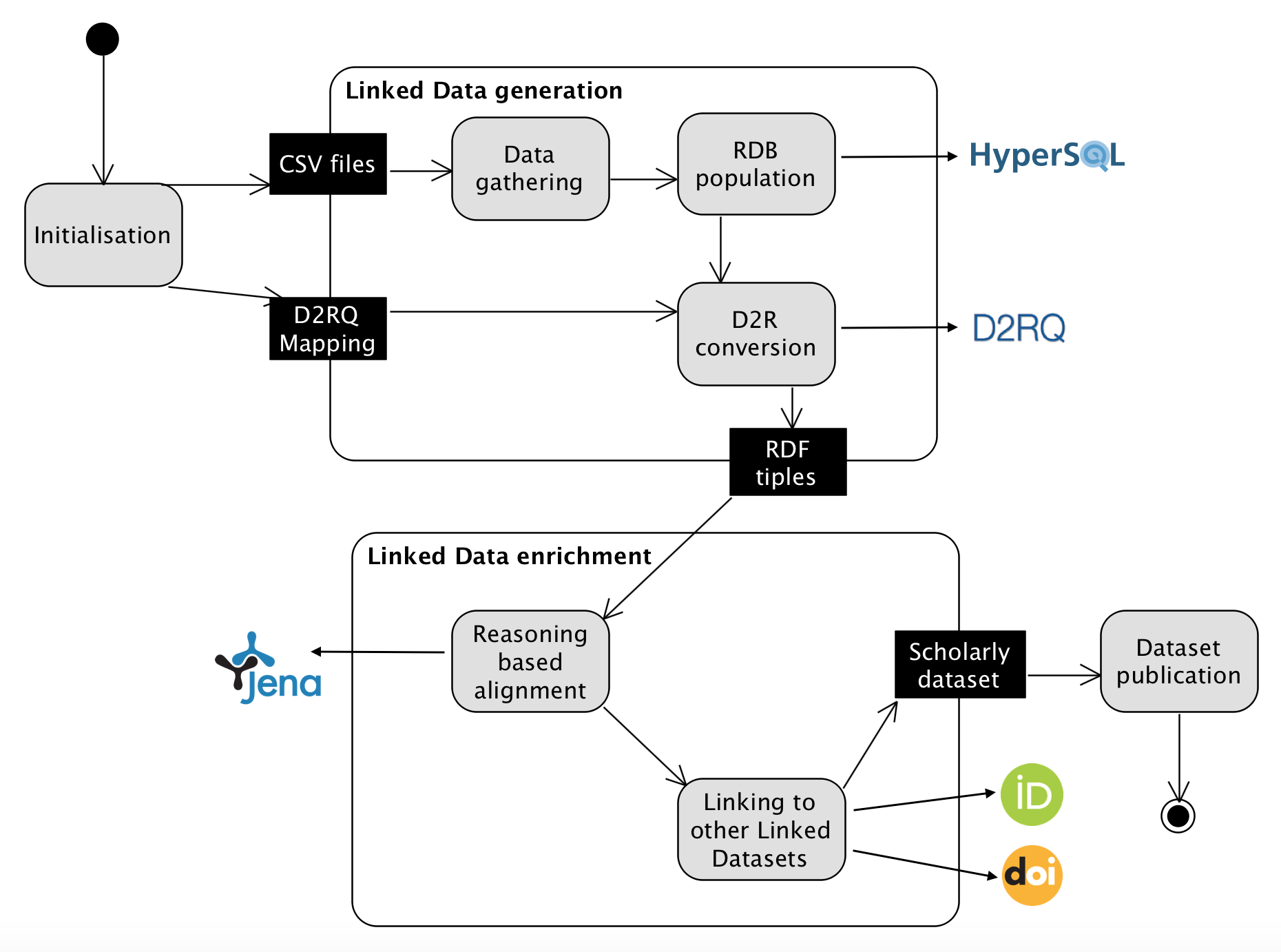cLODg2 - publishing Conference Semantic Data
The main goal of cLODg2 is to facilitate the generation of conference Linked Data which can be readily integrated in the Scholarlydata4 dataset. Scholarlydata is the evolution of the SWDF dataset [5] based on an improvement of the Semantic Web Conference (SWC) Ontology5, the Conference Ontology6[2], which improves SWC adopting best ontology design practices. The necessary steps to add conference data to Scholarlydata are: (i) Data acquisition, (ii) Linked Data generation, (iii) Linked Data enrichment and (iv) Linked Data Publication.
The Data acquisition step, to be done by the user, consists of acquiring metadata about the conference, generally exported from a conference management system. We currently support data acquisition from CSV files7. Additionally, Linked Data represented with the SWC ontology can be used as initial input8.
Starting from provided input cLODg2 performs two sequential steps: Linked Data generation and data enrichment. Figure 1 shows the system architecture, including all accessed services and technologies, modelled as an UML activity diagram. The initialisation step merely consists of configuring a property file to point to (i) the collected CSV files containing the input data and (ii) the D2RQ mapping that will serve for converting CSV files to RDF. A D2RQ mapping for dealing with easychair data is provided by default, but expert users can change this to import ad hoc CSV files.

The Linked Data generation activity is composed of the following steps:
- Data gathering. This action merely represents the system fetching data from the specified location. We remark that for the sake of simplicity we fix the easychair model for the input data, but that this can be easily configured for multiple data gathering support;
- RDB population. This action aims at populating a relational database (RDB) from the CSV files gathered from the previous action. The RDB is based on HyperSQL (HSQLDB)9, which is a lightweight open-source Java database;
- D2R conversion. The previous action, i.e., RDB population, is preparatory to this step. In fact, cLODg2 relies on the D2R framework [4] to perform the conversion of a non-RDF source to RDF. The conversion is guided by the mapping provided as input. This mapping is described by using the D2RQ mapping language [3]. cLODg2 is released along with a default mapping for easychair data and targets two distinct alternative datasets: the SWDF and Scholarlydata.
The Linked Data enrichment activity is composed of the following actions:
- Reasoning-based alignment. Input of this action are the RDF triples produced by the Linked Data generation activity. The output is the materialisation of a set of RDF triples that enable the alignment to other ontologies and vocabularies, i.e., the SWDF ontology, SPAR10, Dolce D011, the Organization Ontology12, FOAF, SKOS, icatzd, and the Collections Ontology13. The alignment triples are materialised by means of OWL-DL reasoning, which is enabled by the Apache Jena inference layer;
- Linking to other Linked Datasets.
This action is aimed at
producing instance level alignments, expressed via
owl:sameAsaxioms. The target linked datasets are ORCID14 and DOI15. ORCID provides persistent digital identifiers for scientific researchers and academic authors. A digital object identifier (DOI) is a serial code used to uniquely identify digital objects, particularly used for electronic documents. The alignments to ORCID are produced by relying on the public API provided by ORCID16. The references to DOI are produced by relying on the API provided by Crossref17, performing a search on each article title.
The Linked Data Publication step, which is the last action in the cLODg2 workflow, has to be done by the user and consists of submitting produced data to Scholarlydata.org.